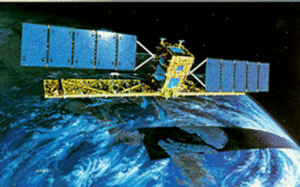Radarsat-1
| Radar satellite 1 | |
|---|---|

|
|
| Type: | Earth observation satellite |
| Country: |
|
| Operator: |
|
| COSPAR-ID : | 1995-059A |
| Mission dates | |
| Dimensions: | 2713 kg |
| Begin: | November 4th 1995 |
| Starting place: | Vandenberg AFB |
| Launcher: | Delta II 7920 |
| Status: | safe mode |
| Orbit data | |
| Rotation time : | 100.7 min |
| Track height: | 798 km |
Radarsat-1 is Canada's first commercial earth observation satellite. A US Delta II rocket placed it in sun-synchronous orbit at an altitude of 798 km on November 4, 1995. The satellite was built by the Canadian company MDA Space Missions . The satellite is operated by the Canadian space agency CSA .
Radarsat-1 carries a swiveling SAR sensor that scans the earth's surface in the C-band (frequency 5.3 GHz, wavelength 5.6 cm). With a high resolution of 10 m it covers an area of 50 km², in wide-angle mode it shows an area of 500 km² with a resolution of 100 m.
The orbital time is 100.7 minutes, it circles the earth 14 times a day. After 24 days he will fly over the same positions on earth. Due to the wide-angle mode and the pivoting of the antenna, it can capture the same places on earth every 5 days, near the poles even daily.
RADARSAT-1 more than doubled its estimated operating time; on March 29, 2013, however, a defect occurred in which the satellite was placed in an energy-saving state. The chances that Radarsat 1 will be fully functional again are slim.
On December 14, 2007 the successor satellite Radarsat-2 was launched from Baikonur with a Soyuz rocket , and on June 12, 2019 the Radarsat Constellation was launched from three identical satellites.
use
In addition to research, the satellite is also used for the International Charter for Space and Natural Disasters .
Web links
- Sensor Description RADARSAT - 1 (English)
- Dettwiler and Associates Ltd. - manufacturer of the satellite with additional technical information (English)
- Heavens Above - Current position of Radarsat 1 (English)
Individual evidence
- ↑ RADARSAT-1 malfunction. Space Daily, April 10, 2013, accessed April 10, 2013 .